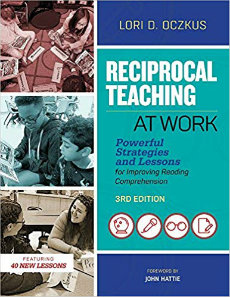Reciprocal Teaching for Improving Reading
Reciprocal Teaching at Work: Powerful Strategies and Lessons for Improving Reading Comprehension 3rd Edition
By Lori D. Oczkus
(ASCD and International Literacy Association, 2018 – Learn more)

Reciprocal teaching is a hot item right now. It seems as though one cannot look at PD offerings or read about new strategies without encountering this wondrous idea of students having the materials and knowledge they need in order to be successful. But what does this truly mean, and how do I implement it in my classroom?
Lori Oczkus discusses this and practical strategies and ideas on implementation for improving literacy in any classroom in the 3rd edition of her book, Reciprocal Teaching at Work: Powerful Strategies and Lessons for Improving Reading Comprehension.

If something is this powerful, one can only ask, “How do I learn this and begin to use it immediately?!” Oczkus, who has a background as a literacy coach and intervention specialist, has prepped a myriad of ways to help educators (and students) navigate this strategy in order to reach its fullest potential.
This first third of the book is dedicated to discussing the research and benefits behind implementing the strategy. Oczkus gives practical, real-classroom ideas on how to begin the new journey with students. They need to be stakeholders in their education, and she discusses how to get them to see the importance of trying something new.
Classroom tested lessons introduce engaging characters
Included in the “Getting Started” part of the book are sample lessons she implemented, with transcripts of what she said and how the students responded. The transcripts are especially useful because they help educators model the correct implementation of the practices. She creates characters out of the four comprehension strategies (Paula the Predictor, Quincy the Questioner, etc.) so the students see they have a real, honest role to play and a specific goal to accomplish in order to “act” their part.
The lessons are broken down into the gradual release model, and there is a “checklist” in many of them for assessment purposes (or on how to divide the groups for the four roles). Most lessons include reproducibles, though their placement in the book makes copying difficult.
For each of the classroom roles, there is an included sentence stem guide for the students to help activate their thinking and engagement with the text. This is especially beneficial for those students who need time to process and organize their thoughts, or the sentence stems can be useful for enrichment / remediation activities.
Perhaps the only downside in this book is the reproducibles. There are great ideas for graphic organizers, but the formatting of the book makes the images smaller than desirable for use in the classroom — there is a lot of space taken up by margins and by the formatting of the book. This is not to say that the reproducibles are useless; there just needs to be some extra effort by educators if they wish to recreate the pages for classroom use.
Helpful images and practical advice
Peppered throughout the text are pictures of classes at work and anchor charts Oczkus has used. These true-life images give a sense of what these lessons would really be like, and they help guide how to get the students to true comprehension, not simply regurgitation.
Overall, this book gives practical advice and ideas on how to engage students in taking ownership of their learning. By getting students to see the value in what they are tasked with completing, and making the classroom roles something fun, students grow as readers and writers, and these comprehension techniques translate into any academic subject.
Erin Corrigan-Smith is a middle school ELA teacher in a suburb of Atlanta. She has a B.A. and M.A. in English, and her focus of study is children’s literature. During the school year, she is faculty advisor to the cooking club and drama club. In her downtime, she enjoys going to her family’s cabin in the North Georgia mountains with her husband and dog to read and relax.




































